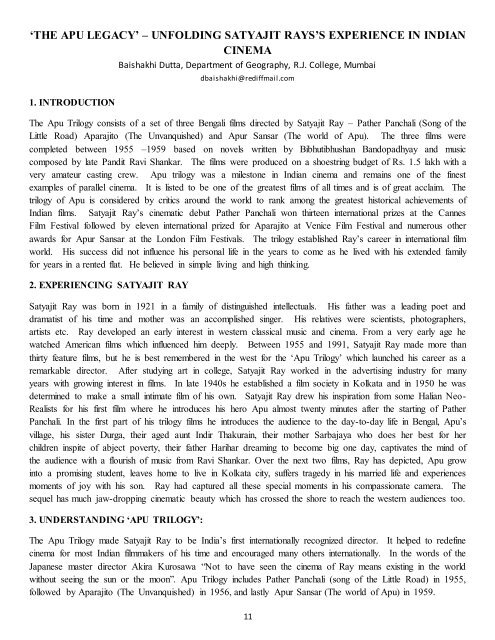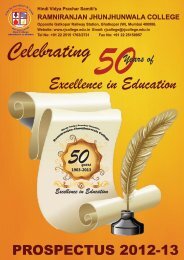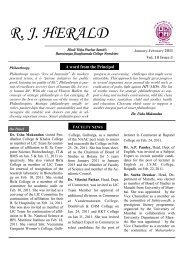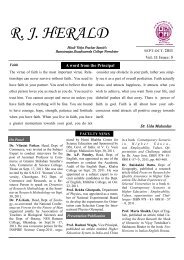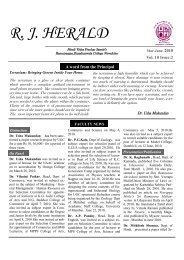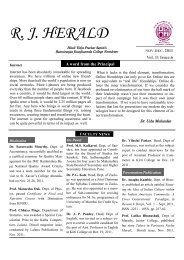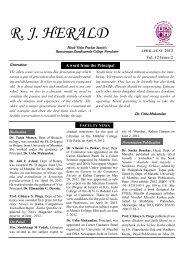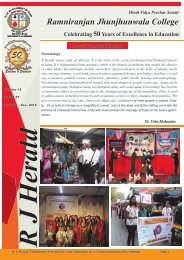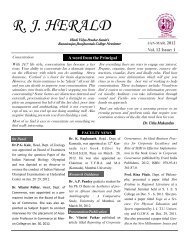ISBN 978-81-925489-2-0 - ramniranjan jhunjhunwala college
ISBN 978-81-925489-2-0 - ramniranjan jhunjhunwala college
ISBN 978-81-925489-2-0 - ramniranjan jhunjhunwala college
Create successful ePaper yourself
Turn your PDF publications into a flip-book with our unique Google optimized e-Paper software.
‘THE APU LEGACY’ – UNFOLDING SATYAJIT RAYS’S EXPERIENCE IN INDIAN<br />
CINEMA<br />
Baishakhi Dutta, Department of Geography, R.J. College, Mumbai<br />
1. INTRODUCTION<br />
dbaishakhi@rediffmail.com<br />
The Apu Trilogy consists of a set of three Bengali films directed by Satyajit Ray – Pather Panchali (Song of the<br />
Little Road) Aparajito (The Unvanquished) and Apur Sansar (The world of Apu). The three films were<br />
completed between 1955 –1959 based on novels written by Bibhutibhushan Bandopadhyay and music<br />
composed by late Pandit Ravi Shankar. The films were produced on a shoestring budget of Rs. 1.5 lakh with a<br />
very amateur casting crew. Apu trilogy was a milestone in Indian cinema and remains one of the finest<br />
examples of parallel cinema. It is listed to be one of the greatest films of all times and is of great acclaim. The<br />
trilogy of Apu is considered by critics around the world to rank among the greatest historical achievements of<br />
Indian films. Satyajit Ray’s cinematic debut Pather Panchali won thirteen international prizes at the Cannes<br />
Film Festival followed by eleven international prized for Aparajito at Venice Film Festival and numerous other<br />
awards for Apur Sansar at the London Film Festivals. The trilogy established Ray’s career in international film<br />
world. His success did not influence his personal life in the years to come as he lived with his extended family<br />
for years in a rented flat. He believed in simple living and high thinking.<br />
2. EXPERIENCING SATYAJIT RAY<br />
Satyajit Ray was born in 1921 in a family of distinguished intellectuals. His father was a leading poet and<br />
dramatist of his time and mother was an accomplished singer. His relatives were scientists, photographers,<br />
artists etc. Ray developed an early interest in western classical music and cinema. From a very early age he<br />
watched American films which influenced him deeply. Between 1955 and 1991, Satyajit Ray made more than<br />
thirty feature films, but he is best remembered in the west for the ‘Apu Trilogy’ which launched his career as a<br />
remarkable director. After studying art in <strong>college</strong>, Satyajit Ray worked in the advertising industry for many<br />
years with growing interest in films. In late 1940s he established a film society in Kolkata and in 1950 he was<br />
determined to make a small intimate film of his own. Satyajit Ray drew his inspiration from some Halian Neo-<br />
Realists for his first film where he introduces his hero Apu almost twenty minutes after the starting of Pather<br />
Panchali. In the first part of his trilogy films he introduces the audience to the day-to-day life in Bengal, Apu’s<br />
village, his sister Durga, their aged aunt Indir Thakurain, their mother Sarbajaya who does her best for her<br />
children inspite of abject poverty, their father Harihar dreaming to become big one day, captivates the mind of<br />
the audience with a flourish of music from Ravi Shankar. Over the next two films, Ray has depicted, Apu grow<br />
into a promising student, leaves home to live in Kolkata city, suffers tragedy in his married life and experiences<br />
moments of joy with his son. Ray had captured all these special moments in his compassionate camera. The<br />
sequel has much jaw-dropping cinematic beauty which has crossed the shore to reach the western audiences too.<br />
3. UNDERSTANDING ‘APU TRILOGY’:<br />
The Apu Trilogy made Satyajit Ray to be India’s first internationally recognized director. It helped to redefine<br />
cinema for most Indian filmmakers of his time and encouraged many others internationally. In the words of the<br />
Japanese master director Akira Kurosawa “Not to have seen the cinema of Ray means existing in the world<br />
without seeing the sun or the moon”. Apu Trilogy includes Pather Panchali (song of the Little Road) in 1955,<br />
followed by Aparajito (The Unvanquished) in 1956, and lastly Apur Sansar (The world of Apu) in 1959.<br />
11


